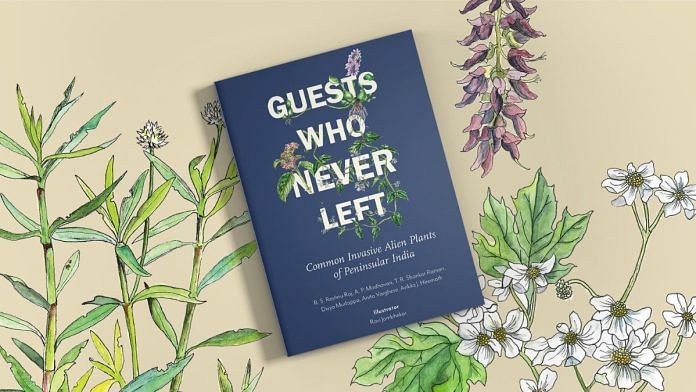New Delhi: The lantana camara with its carpet of pretty flowers is synonymous with invasion in India. The non-native species is resistant to destruction and a threat to wildlife habitats. But there is another invasive species which has contributed to a half-a-billion-dollar industry—coffee.
They’re two of the 50 plants mentioned in the new book, Guests Who Never Left: Common Invasive Alien Plants in Peninsular India. Published by the Biodiversity Collaborative and the Nature Conservation Foundation, the book is an effort of six ecologists, conservationists and biodiversity academics to document India’s alien invasive species.
India has an abysmal record of documenting invasive plants, with only 2,176 entries in the Global Register for Introduced and Invasive Species. In comparison, France, which is one-sixth the size of India, has 3,181.
According to ecologist Ankila Hiremath who is one of the authors, the biggest issue against managing invasive species in the country is lack of information.
“The collective sense among those who work on invasive species is that very few people are aware of their ecological and socio-economic impacts,” she told ThePrint.
The growth of lantana, which is one the few well-documented invasive species, threatens 40 per cent of India’s tiger habitats.
“I guess in India we only have the space for one environmental disaster at a time, and biological invasions are not at the top,” said Alok Bang, an ecologist at Azim Premji University, during the online launch of the book on 9 November. The 220-page book was co-written by Anita Verghese, director of the Keystone Foundation which works in the Nilgiri Biosphere Reserve. During the launch, Verghese highlighted how along with government policies, citizen science can also help in combating invasive species.
“But how do you get people interested in plants? Wildlife, birds or butterflies have more action, they’re more interesting,” said Verghese at the launch. She then explained how local indigenous communities living near the Nilgiris in Tamil Nadu helped identify many of the invasive species logged in the book.
The book divides the plant species into four categories: climbers, shrubs, herbs and trees. Aside from identification, the book also expands on the impacts of the plants on native species, and ways to manage and control their growth.
“People are surprised to know that some ornamental flowers and beautiful trees we see and like are actually invasive species,” said Hiremath.
The garden varieties that Hiremath speaks of include plants like the Garden Cosmos, a pink flower that originated in South America. It was introduced in India as an ornamental plant by horticulturists, but its self-seeding ability allows it to escape cultivation and become invasive.
Other common plants that are invasive are the Mexican Poppy, a yellow flower that is found on roadsides and near fields and is toxic to humans and animals alike. In Hindi, it is aptly called ‘Satyanashi’ or destroyer.
Also Read: India among 190 nations to agree to ‘historic’ framework to ‘halt & reverse’ biodiversity loss
What can be done?
Citizen initiatives and public interest can take efforts to stem plants like the ‘destroyer’ only so far. Larger policy questions on how to combat invasive species in ecosystems and save degraded landscapes were part of the discussion. And everyone agreed on the need for government intervention to solve the crisis through regular monitoring, eradication, and control.
“The problem is extremely serious with huge stretches of our land taken over by invasive species like lantana camara,” said Udhayan A, director of the Advanced Institute of Wildlife Conservation in Tamil Nadu and former Indian Forest Services officer who was one of the invited speakers.
He spoke of the Tamil Nadu government’s Policy on Invasive Plants and Ecological Restoration (TN-PIPER) which is the first state policy in India aimed at addressing harmful invasive species. With boots on the ground, the forest department, too, has a part to play in this.
Their efforts can be bolstered by artificial intelligence along with specific geospatial tools, to understand the extent of the spread of invasive species in the country. Citizen science was also called upon for the cause by speakers such as TR Shankar Raman, a wildlife scientist and one of the authors of the book.
Apart from monitoring and management of invasive species, the session highlighted ways in which some invasive species were dealt with by local communities in the Nilgiri hills.
The lantana camara inhibits native plants and damages soil quality. Villagers of the Nilgiri hills learnt to make huge elephant sculptures out of this invasive weed — thus highlighting the problems they faced with the weed. These ‘lantana elephants’ were displayed in London parks in 2021 too.
“Sometimes you cannot eradicate an invasive species—so you learn to live with it. You find a balance, like nature intends,” said Bang.
(Edited by Theres Sudeep)



